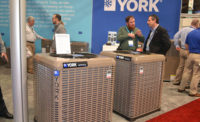Smart HVAC systems keep critical control and maintenance data automatically updated and easily accessible. Customers remotely customize their settings through apps, and contractors access early alerts and critical diagnostics in online reports. Sophisticated products can even integrate weather predictions and energy usage trends to minimize power consumption and optimize temperature regulation. As sustainability becomes an increasing focus for individuals, businesses, and communities alike, IoT-enabled HVAC systems can accommodate a seamless user experience while reducing environmental impact.
The Internet of Things
The Internet of Things (IoT) enables smart features of many technologies, including HVAC systems. Advanced IoT-enabled sensors can provide a wealth of information relevant to HVAC customers, manufacturers, and maintainers. Sensors gather measurements on indoor air temperature, outdoor radiant temperature, indoor and outdoor humidity, air speed, and circulation patterns, to name a few. The smart sensors transfer this information to a central database, which connects the HVAC system to the power of the internet — exporting status to apps and dashboards and importing information like weather forecasts and user preferences. These forecasts and preferences drive automatic HVAC system adjustments and can command actuators from behind-the-scenes without waiting on input from a user.

HVAC IoT NETWORK: Users, weather reports, and sensors work together to optimize IoT-enabled HVAC systems. Courtesy MDPI, available under Creative Commons 4.0.
Smart sensors can communicate over existing Wi-Fi networks, cellular connection, Bluetooth, or other proprietary connections. This provides flexibility and adaptability based on the needs of a particular HVAC system configuration. Connectivity is a key aspect of any IoT system, as this allows components to communicate with each other for seamless, automatic adjustments and provides a gateway for the sensors to share and collect information externally.
More Control For Customers
Advanced systems are able to moderate more than just temperature, and they continuously adjust system parameters for perfect thermal comfort. Customers can customize how the system factors in outdoor temperature, home insulation, humidity, and related parameters, or they can allow the IoT system to optimize these settings automatically.
Dashboards are a one-stop shop to check performance, update settings, and view energy consumption trends. Some systems will even calculate carbon footprint changes based on current usage statistics and will project future costs based on planned consumption rates. Continuous access to system status provides transparency, predictability, and peace of mind for both residential and commercial customers. It also enables customers to take more control over both their financial expenditures and their environmental impact. The Department of Energy reports that HVAC accounts for 42% of Americans’ utility bills, and upgrading to more sophisticated HVAC systems can reduce a customer’s monthly energy costs by 30% on average.
Early Alerts For Maintenance
Early versions of smart HVAC systems may simply warn users of potential maintenance concerns, but end-to-end services are emerging. These services provide a platform that connects HVAC users with contractors and maintenance providers and that quickly shares critical maintenance data with contractors. Some go a step further and automatically schedule maintenance or call emergency technicians as soon as the smart sensors detect a problem. Sensors are highly adaptable, and are able to detect water leaks to automatically shut off a system, indicate a dirty filter that needs to be changed, or generate an alert that a blower is running slowly and reducing system performance. As they arrive at the unit, technicians already have access to essential diagnostic information to get a head start on assessing and addressing the problem. Smart HVAC systems provide faster response times, scheduling predictability, and more accurate repair assessments, even when customers are away from their property.
Improving Sustainability
While user comfort has been paramount in the design of HVAC systems since their inception, customers and communities have placed an increasing emphasis on sustainable technology. According to the Energy and Buildings Journal, energy consumption devoted to HVAC in both residential and commercial buildings is between 20% to 40% of overall energy consumption in developed countries. This share is greater than both industrial energy use and transportation energy costs. Fortunately, applying IoT to HVAC systems shows promise for exceeding temperature comfort expectations while optimizing energy usage. Smart HVAC systems are able to optimize power consumption on a case-by-case basis in real time, without any interruption in service.
Artificial intelligence (AI) algorithms integrate information between the internal HVAC system and the outside world to moderate thermal comfort and energy use. AI-enhanced smart systems have proven to be significantly more effective at both temperature and power regulation than traditional thermostats. In a 2020 study, an AI-enabled smart HVAC system increased customer comfort from 75% to 95% while reducing daily energy usage by 20% during peak summer heat. These advanced algorithms can adapt to any climate, building, user preference, or energy goal, satisfying a wide range of customer needs.
Future Exploration
Many industries are continuing to fund IoT research, developing new features and driving down costs. Various price points and feature levels appeal to a broad range of residential and commercial customers. Advances in computing, like artificial intelligence, complement IoT improvements and highlight new applications. The software-centric nature of smart systems enables low-effort and low-cost upgrades in the future. Dashboards bring the wealth of information IoT systems provide to users’ fingertips, customizing controls and streamlining maintenance. Customers are able to tweak their systems to their exact needs, and contractors have critical diagnostic information readily available. Balancing energy needs has garnered attention from individuals, businesses, and communities alike; smart systems have demonstrated a significant reduction in energy usage without sacrificing temperature regulation. Smart HVAC systems have already proven their ability to provide user customization, generate maintenance alerts, maximize comfort, and reduce energy consumption, and they will continue to improve as IoT technology grows.








